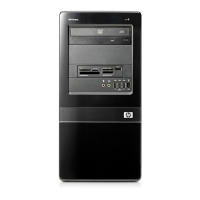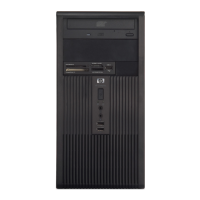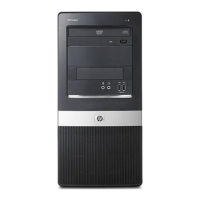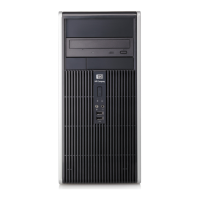Table 4-1 Security Features Overview
Option Description
Setup Password Allows you to set and enable setup (administrator) password.
NOTE: If the setup password is set, it is required to change Computer Setup
options, flash the ROM, and make changes to certain plug and play settings
under Windows.
See the Computer Setup (F10) Utility Guide on the Documentation and
Diagnostics CD for more information.
Power-On Password Allows you to set and enable power-on password.
See the Computer Setup (F10) Utility Guide on the Documentation and
Diagnostics CD for more information.
Password Options
(This selection will appear only if a
power-on password is set.)
Allows you to specify whether the password is required for warm boot (Ctrl
+Alt+Del).
See the Computer Setup (F10) Utility Guide on the Documentation and
Diagnostics CD for more information.
Pre-Boot Authorization Allows you to enable/disable the Smart Card to be used in place of the Power-
On Password.
Smart Cover Allows you to:
●
Enable/disable the Cover Lock.
●
Enable/disable the Cover Removal Sensor.
NOTE: Notify User alerts the user that the sensor has detected that the
cover has been removed. Setup Password requires that the setup password
be entered to boot the computer if the sensor detects that the cover has been
removed.
This feature is supported on some models only. See the Computer Setup
(F10) Utility Guide on the Documentation and Diagnostics CD for more
information.
Embedded Security Allows you to:
●
Enable/disable the Embedded Security device.
●
Reset the device to Factory Settings.
This feature is supported on some models only. See the HP ProtectTools
Security Manager Guide at
http://www.hp.com
Device Security Enables/disables serial ports, parallel port, front USB ports, system audio,
network controllers (some models), and SCSI controllers (some models).
Network Service Boot Enables/disables the computer’s ability to boot from an operating system
installed on a network server. (The network controller must reside on the PCI
bus or be embedded on the system board.)
System IDs Allows you to set:
●
Asset tag (18-byte identifier) and ownership Tag (80-byte identifier
displayed during POST). See the Computer Setup (F10) Utility Guide
on the Documentation and Diagnostics CD for more information.
●
Chassis serial number or Universal Unique Identifier (UUID) number.
The UUID can only be updated if the current chassis serial number is
invalid. (These ID numbers are normally set in the factory and are used
to uniquely identify the system.)
Asset Tracking and Security 37

